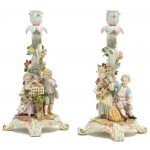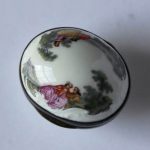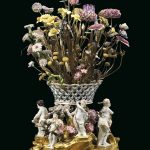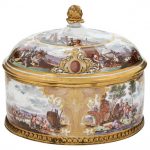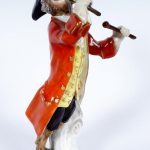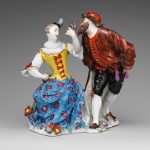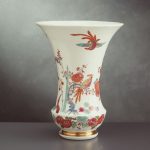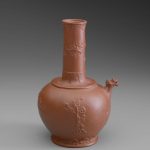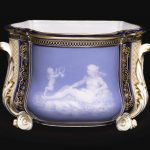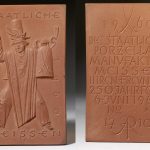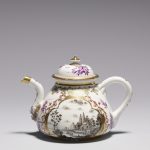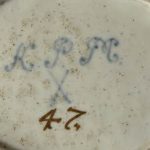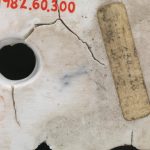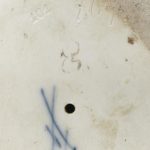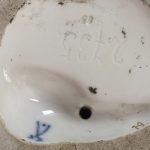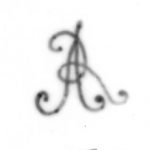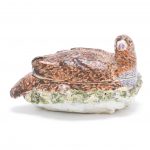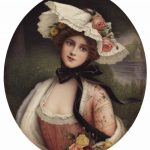Information and makers marks for Meissen porcelain. The Meissen Porcelain Factory is located in the town of Meissen, near Dresden, in Saxony. It was the first hard-paste porcelain manufacturer in Europe, thanks to the 1708 discovery of the secret of porcelain by Johann Friedrich Böttger and Ehrenfried Walther von Tschirnhaus. Products are still made by hand, ensuring that a high standard of quality is always achieved. In the early-twentieth century the factory introduced new patterns, in response to changing fashions, and began to commission designers to create new forms. The ‘T glatt’ service is one example of this practice. Reference: The British Museum.
Highly admired for its lightness, translucency and mysterious origin, Chinese porcelains became more easily available in Europe from the late 14th century. For the next three centuries Europeans tried, and failed, to emulate the secret Chinese recipe for true or hard-paste porcelain.
The breakthrough came in 1709, two years after the German alchemist, Johann Friedrich Bottger, abandoned his attempts at making gold in favour of porcelain research. His patron, the great porcelain collector Augustus the Strong, King of Poland and Saxon Elector, set up the first European porcelain manufactory in Meissen, Germany, in 1710. Reference: Museum of Applied Arts and Sciences.
A pair of Meissen porcelain figural candlesticks emblematic of spring and summer and a Meissen porcelain figural candlestick late 19th century Each with underglaze blue crossed swords, incised 783 and 784, each impressed 70 and painted 43. height 12 3/8in (31.5cm)
Sold for US$ 2,500 (£ 1,905) inc. premium at Bonhams in 2018
Meissen vinaigrette; porcelain; egg-shaped; enamelled Watteau figures in landscapes and raised white scroll hands; silver mounts.
Reproduced by permission of the artist. © The Trustees of the British Museum
A LOUIS XV ORMOLU-MOUNTED MEISSEN AND VINCENNES PORCELAIN CENTREPIECE CIRCA 1745-49 The pierced rockwork and rocaille-moulded ormolu base mounted with seven Meissen putti, emblematic of the Arts and Sciences, below a pierced circular Meissen basket issuing gilt-metal leafy branches mounted with porcelain garden flowers forming an arrangement; the ormolu base struck with the ‘C’ Couronné Poinçon, a few flowers possibly replaced in the 19th century 21 ¾ in. (52.7 cm.) high overall
Sold for GBP 47,500 at Christies in 2018
Meissen Gilt-Metal Mounted, Gilt and Polychrome Decorated Porcelain Circular Box with a Continental Silver Liner Height 5 inches, diameter 5 7/8 inches.
Body: has been extensively, professionally restored; including complete overpainting to interior side, as well las the underside and consequently no marks are visible; close examination of the body on exterior side reveals approximately 5 hairline cracks to the body that extend from top to bottom in either a straight vertical direction or on a diagonal; there is a gold painted band at the top interior side of the box Cover: appears to be in generally good condition; it appears that the finial has been professionally reaffixed and may in fact be a later replacement; no apparent flake losses to the painted decoration or to the gilding; lid fits securely into the box; some bubbles to surface, especially to rim Dutch Silver liner: appears to be in generally good condition; there is a concentration of scratch marks in the center to the interior side as well as some dings and dents; silver is hallmarked; raised on 3 feet
Sold for $1,250 (includes buyer’s premium) at Doyle New York in 2018
19th Century Meissen Monkey Band Drummer
Figural standing monkey with drumsticks, base marked with blue cross swords, impressed 12, 16, gold painted 27. Measures 5 1/2″ h. Condition: No repairs, chips, or cracks under black light.
Sold for $325 at Amero Auctions in 2018
Meissen Columbine and Pantaloon Figure circa 1736
The figure of Pantaloon was inspired by ‘Pantalon Ancien”, François Joullain engraving after Callot published by Louis Riccoboni, in his Histoire du Théâtre Italien, Paris, 1728, pl. 3.
Reference: The Metropolitan Museum of Art
Meissen ware vase probably painted by Johann Ehrenfried Stadler
A large trumpet-shaped vase with low shoulders made from hard-paste porcelain. The vase is hand-painted in Kakiemon colours – red, magenta, light blue, turquoise and yellow – with ‘indianische Blumen’ (indian flowers) and two peacocks and bird of paradise. The low circular base is decorated with a gilt banding. Marked on base in underglaze blue ‘AR.’ for Augustus Rex
Reference: Museum of Applied Arts & Sciences
Bottle German about 1710–15 Made at Meissen Manufactory (Germany)
Redware. Based on a kendi. Bulbous body with animal head spot on shoulder & four groups of raised floral design. Long cylindrical neck with raised and incised bands of decoration. In the 1710s Meissen reproduced the shapes of Chinese and Japanese ceramics in the collection of its patron, Augustus the Strong. This bottle takes the form of a kendi, a water vessel popular throughout East Asia.
Reference: Museum of Fine Arts Boston
A Meissen pâte-sur-pâte bough pot circa 1890 of lobed D-section, decorated on the front in white slip with a reclining maiden and cherub on a pale blue ground and on the reverse with a trophy, within elaborately gilt tooled foliate borders, affixed on either side with leaf-molded handles and set on four scroll feet, crossed swords marks in underglaze-blue, impressed shape number R67 and 4. length across handles 9 3/4 in. 24.8 cm
Sold for 12,500 USD at Sothebys in 2018
Rectangular red stoneware plaque, the front bearing a raised figure, with covered card presentation box, Meissen porcelain factory, Germany, 1960
The plaque is in the same commemorative vein as a series of New Year red stoneware plaques produced by Meissen from 1918 to 1934 which were designed by various well-known Meissen designers. Meissen used such plaques as those, and this one, as presentation pieces which made attractive gifts as well as serving to promote Meissen and its designers.
Reference: © Victoria and Albert Museum
Meissen teapot circa
Apart from the superb quality of the decoration and its early date, this teapot is significant for a number of reasons. It bears the underglaze blue mark KPM (Königliche Porzellan Manufaktur), which was used in 1724-25 to distinguish the Meissen porcelains decorated at the royal factory from those decorated by “hausmalerei,” or independent workers. It also avoided confusion with the wares produced in Vienna where underglaze blue had not yet been introduced. The scrollwork decoration is an exceptional example of gilding as practiced at Meissen at this time. The small size of the teapot is indicative of the high cost of tea in the early 18th century.
Reference: The Walter Art Museum
Meissen KPM Mark
Meissen Mark circa 1730s
Meissen Mark mid 19th century
Meissen Mark circa 1920s
Meissen mark AR for Augustus Rex
